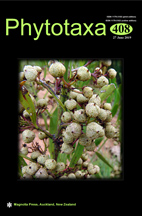Abstract
A new wood-inhabiting species, Neofavolus yunnanensis, is proposed based on a combination of morphological features and molecular evidence. The species is characterized by an annual growth, laterally stipitate basidiomata with reniform to semicircular pileus, dimitic hyphal system with clamped generative hyphae, IKI–, CB–, and cylindrical, hyaline, thin-walled, smooth, IKI–, CB– basidiospores. Sequences of ITS and LSU nrRNA gene regions of the studied samples were generated, and phylogenetic analyses were performed with maximum likelihood, maximum parsimony and Bayesian inference methods. The phylogenetic analyses showed that N. yunnanensis was nested into the genus Neofavolus and then was as a sister with N. mikawae and then grouped with N. alveolaris and N. cremeoalbidus.

